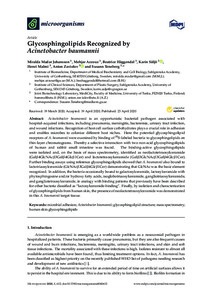Glycosphingolipids Recognized by Acinetobacter baumannii
Miralda Madar Johansson; Mehjar Azzouz; Beatrice Häggendal; Karin Säljö; Henri Malmi; Anton Zaviolov; Susann Teneberg
Glycosphingolipids Recognized by Acinetobacter baumannii
Miralda Madar Johansson
Mehjar Azzouz
Beatrice Häggendal
Karin Säljö
Henri Malmi
Anton Zaviolov
Susann Teneberg
MDPI
Julkaisun pysyvä osoite on:
https://urn.fi/URN:NBN:fi-fe2021042824368
https://urn.fi/URN:NBN:fi-fe2021042824368
Tiivistelmä
Acinetobacter baumannii is an opportunistic bacterial pathogen associated with hospital-acquired infections, including pneumonia, meningitis, bacteremia, urinary tract infection, and wound infections. Recognition of host cell surface carbohydrates plays a crucial role in adhesion and enables microbes to colonize different host niches. Here the potential glycosphingolipid receptors of A. baumannii were examined by binding of S-35-labeled bacteria to glycosphingolipids on thin-layer chromatograms. Thereby a selective interaction with two non-acid glycosphingolipids of human and rabbit small intestine was found. The binding-active glycosphingolipids were isolated and, on the basis of mass spectrometry, identified as neolactotetraosylceramide (Gal beta 4GlcNAc beta 3Gal beta 4Glc beta 1Cer) and lactotetraosylceramide (Gal beta 3GlcNAc beta 3Gal beta 4Glc beta 1Cer). Further binding assays using reference glycosphingolipids showed that A. baumannii also bound to lactotriaosylceramide (GlcNAc beta 3Gal beta 4Glc beta 1Cer) demonstrating that GlcNAc was the basic element recognized. In addition, the bacteria occasionally bound to galactosylceramide, lactosylceramide with phytosphingosine and/or hydroxy fatty acids, isoglobotriaosylceramide, gangliotriaosylceramide, and gangliotetraosylceramide, in analogy with binding patterns that previously have been described for other bacteria classified as "lactosylceramide-binding". Finally, by isolation and characterization of glycosphingolipids from human skin, the presence of neolactotetraosylceramide was demonstrated in this A. baumannii target tissue.
Kokoelmat
- Rinnakkaistallenteet [27094]
